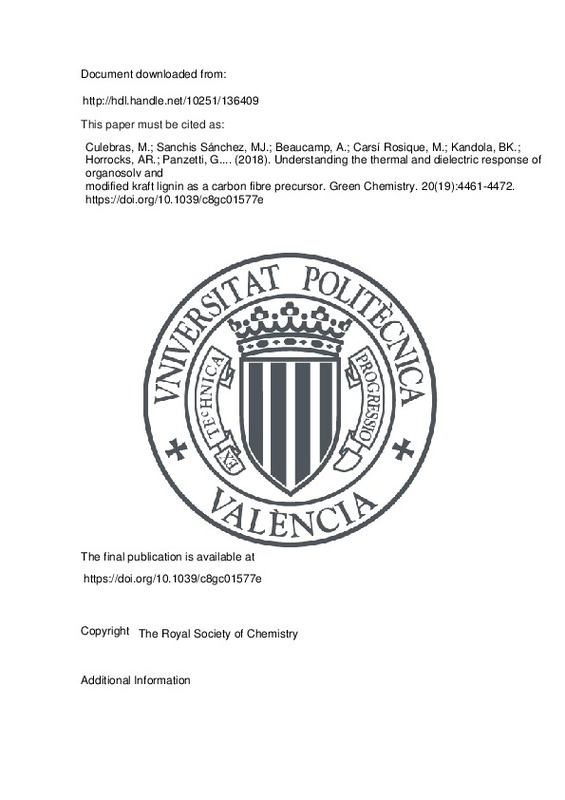Figueiredo, P., Lintinen, K., Hirvonen, J. T., Kostiainen, M. A., & Santos, H. A. (2018). Properties and chemical modifications of lignin: Towards lignin-based nanomaterials for biomedical applications. Progress in Materials Science, 93, 233-269. doi:10.1016/j.pmatsci.2017.12.001
Barakat, A., Monlau, F., Steyer, J.-P., & Carrere, H. (2012). Effect of lignin-derived and furan compounds found in lignocellulosic hydrolysates on biomethane production. Bioresource Technology, 104, 90-99. doi:10.1016/j.biortech.2011.10.060
P. Pessala , E.Schultz , S.Luukkainen , S.Herve , J.Knuutinen and J.Paasivirta , Pulp & paper mill effluent: environmental fate & effects , 2004 , pp. 319–330
[+]
Figueiredo, P., Lintinen, K., Hirvonen, J. T., Kostiainen, M. A., & Santos, H. A. (2018). Properties and chemical modifications of lignin: Towards lignin-based nanomaterials for biomedical applications. Progress in Materials Science, 93, 233-269. doi:10.1016/j.pmatsci.2017.12.001
Barakat, A., Monlau, F., Steyer, J.-P., & Carrere, H. (2012). Effect of lignin-derived and furan compounds found in lignocellulosic hydrolysates on biomethane production. Bioresource Technology, 104, 90-99. doi:10.1016/j.biortech.2011.10.060
P. Pessala , E.Schultz , S.Luukkainen , S.Herve , J.Knuutinen and J.Paasivirta , Pulp & paper mill effluent: environmental fate & effects , 2004 , pp. 319–330
Hossain, M. M., Scott, I. M., McGarvey, B. D., Conn, K., Ferrante, L., Berruti, F., & Briens, C. (2013). Toxicity of lignin, cellulose and hemicellulose-pyrolyzed bio-oil combinations: Estimating pesticide resources. Journal of Analytical and Applied Pyrolysis, 99, 211-216. doi:10.1016/j.jaap.2012.07.008
Wang, C., Kelley, S. S., & Venditti, R. A. (2016). Lignin-Based Thermoplastic Materials. ChemSusChem, 9(8), 770-783. doi:10.1002/cssc.201501531
Mainka, H., Täger, O., Körner, E., Hilfert, L., Busse, S., Edelmann, F. T., & Herrmann, A. S. (2015). Lignin – an alternative precursor for sustainable and cost-effective automotive carbon fiber. Journal of Materials Research and Technology, 4(3), 283-296. doi:10.1016/j.jmrt.2015.03.004
Lupoi, J. S., Singh, S., Parthasarathi, R., Simmons, B. A., & Henry, R. J. (2015). Recent innovations in analytical methods for the qualitative and quantitative assessment of lignin. Renewable and Sustainable Energy Reviews, 49, 871-906. doi:10.1016/j.rser.2015.04.091
Zhu, H., Luo, W., Ciesielski, P. N., Fang, Z., Zhu, J. Y., Henriksson, G., … Hu, L. (2016). Wood-Derived Materials for Green Electronics, Biological Devices, and Energy Applications. Chemical Reviews, 116(16), 9305-9374. doi:10.1021/acs.chemrev.6b00225
Effendi, A., Gerhauser, H., & Bridgwater, A. V. (2008). Production of renewable phenolic resins by thermochemical conversion of biomass: A review. Renewable and Sustainable Energy Reviews, 12(8), 2092-2116. doi:10.1016/j.rser.2007.04.008
De Chirico, A., Armanini, M., Chini, P., Cioccolo, G., Provasoli, F., & Audisio, G. (2003). Flame retardants for polypropylene based on lignin. Polymer Degradation and Stability, 79(1), 139-145. doi:10.1016/s0141-3910(02)00266-5
Zhang, R., Xiao, X., Tai, Q., Huang, H., & Hu, Y. (2012). Modification of lignin and its application as char agent in intumescent flame-retardant poly(lactic acid). Polymer Engineering & Science, 52(12), 2620-2626. doi:10.1002/pen.23214
Costes, L., Laoutid, F., Brohez, S., Delvosalle, C., & Dubois, P. (2017). Phytic acid–lignin combination: A simple and efficient route for enhancing thermal and flame retardant properties of polylactide. European Polymer Journal, 94, 270-285. doi:10.1016/j.eurpolymj.2017.07.018
Pan, X., Kadla, J. F., Ehara, K., Gilkes, N., & Saddler, J. N. (2006). Organosolv Ethanol Lignin from Hybrid Poplar as a Radical Scavenger: Relationship between Lignin Structure, Extraction Conditions, and Antioxidant Activity. Journal of Agricultural and Food Chemistry, 54(16), 5806-5813. doi:10.1021/jf0605392
Chae, H. G., & Kumar, S. (2008). Making Strong Fibers. Science, 319(5865), 908-909. doi:10.1126/science.1153911
G. F. Zakis , Functional analysis of lignins and their derivatives , Atlanta , 1994
Garden, L., & Pethrick, R. A. (2017). Critique of dielectric cure monitoring in epoxy resins – Does the method work for commercial formulations? International Journal of Adhesion and Adhesives, 74, 6-14. doi:10.1016/j.ijadhadh.2016.12.005
Jakobsen, J., Skordos, A., James, S., Correia, R. G., & Jensen, M. (2015). In-situ Curing Strain Monitoring of a Flat Plate Residual Stress Specimen Using a Chopped Stand Mat Glass/Epoxy Composite as Test Material. Applied Composite Materials, 22(6), 805-822. doi:10.1007/s10443-015-9437-4
A. Schönhals and F.Kremer , in Broadband dielectric spectroscopy , Springer , 2003 , pp. 59–98
Perticaroli, S., Mostofian, B., Ehlers, G., Neuefeind, J. C., Diallo, S. O., Stanley, C. B., … Nickels, J. D. (2017). Structural relaxation, viscosity, and network connectivity in a hydrogen bonding liquid. Physical Chemistry Chemical Physics, 19(38), 25859-25869. doi:10.1039/c7cp04013j
Sait, H. H., & Salema, A. A. (2015). Microwave dielectric characterization of Saudi Arabian date palm biomass during pyrolysis and at industrial frequencies. Fuel, 161, 239-247. doi:10.1016/j.fuel.2015.08.058
Salema, A. A., Ani, F. N., Mouris, J., & Hutcheon, R. (2017). Microwave dielectric properties of Malaysian palm oil and agricultural industrial biomass and biochar during pyrolysis process. Fuel Processing Technology, 166, 164-173. doi:10.1016/j.fuproc.2017.06.006
Guidara, S., Feki, H., & Abid, Y. (2016). High-temperature dehydration behavior and ionic conduction of 2,5-dimethylanilinium chloride monohydrate. Journal of Alloys and Compounds, 672, 86-92. doi:10.1016/j.jallcom.2016.02.110
Bellucci, F., Valentino, M., Monetta, T., Nicodemo, L., Kenny, J., Nicolais, L., & Mijovic, J. (1994). Impedance spectroscopy of reactive polymers. 1. Journal of Polymer Science Part B: Polymer Physics, 32(15), 2519-2527. doi:10.1002/polb.1994.090321509
Bellucci, F., Valentino, M., Monetta, T., Nicodemo, L., Kenny, J., Nicolais, L., & Mijovic, J. (1995). Impedance spectroscopy of reactive polymers. 2. Multifunctional epoxy/amine formulations. Journal of Polymer Science Part B: Polymer Physics, 33(3), 433-443. doi:10.1002/polb.1995.090330312
Mijović, J., Bellucci, F., & Nicolais, L. (1995). Impedance Spectroscopy of Reactive Polymers: Correlations with Chemorheology during Network Formation. Journal of The Electrochemical Society, 142(4), 1176-1182. doi:10.1149/1.2044148
Gallone, G., Levita, J., Mijovic, S., Andjelic, S., & Rolla, P. A. (1998). Anomalous trends in conductivity during epoxy—amine reactions. Polymer, 39(11), 2095-2102. doi:10.1016/s0032-3861(97)00528-4
Šantić, A., Wrobel, W., Mutke, M., Banhatti, R. D., & Funke, K. (2009). Frequency-dependent fluidity and conductivity of an ionic liquid. Physical Chemistry Chemical Physics, 11(28), 5930. doi:10.1039/b904186a
Ghaouar, N. (2018). Comments on the analogy by adaptation of formulas between the viscosity and the electrical conductivity. Journal of Molecular Liquids, 250, 278-282. doi:10.1016/j.molliq.2017.12.020
LISPERGUER, J., PEREZ, P., & URIZAR, S. (2009). STRUCTURE AND THERMAL PROPERTIES OF LIGNINS: CHARACTERIZATION BY INFRARED SPECTROSCOPY AND DIFFERENTIAL SCANNING CALORIMETRY. Journal of the Chilean Chemical Society, 54(4). doi:10.4067/s0717-97072009000400030
[-]







![[Cerrado]](/themes/UPV/images/candado.png)


